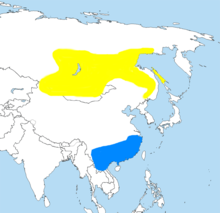Pallas's warbler
| Pallas's leaf warbler | |
|---|---|
 |
|
| Scientific classification | |
| Kingdom: | Animalia |
| Phylum: | Chordata |
| Class: | Aves |
| Order: | Passeriformes |
| Family: | Phylloscopidae |
| Genus: | Phylloscopus |
| Species: | P. proregulus |
| Binomial name | |
|
Phylloscopus proregulus (Pallas, 1811) |
|
 |
|
|
Breeding summer visitor
(ranges are approximate)Winter visitor |
|
The Pallas's leaf warbler or Pallas's warbler (Phylloscopus proregulus) is a bird that breeds in mountain forests from southern Siberia east to northern Mongolia and northeast China. It is named for German zoologist Peter Simon Pallas, who first formally described it. This leaf warbler is strongly migratory, wintering mainly in south China and adjacent areas of southeast Asia, although in recent decades increasing numbers have been found in Europe in autumn.
Pallas's leaf warbler is one of the smallest Eurasian warblers, with a relatively large head and short tail. It has greenish upperparts and white underparts, a lemon-yellow rump, and yellow double wingbars, supercilia and central crown stripe. It is similar in appearance to several other Asian warblers, including some that were formerly considered to be its subspecies, although its distinctive vocalisations aid identification.
The female builds a cup nest in a tree or bush, and incubates the four to six eggs, which hatch after 12–13 days. The chicks are fed mainly by the female and fledge when they are 12–14 days old; both parents then bring food for about a week. Pallas's leaf warbler is insectivorous, feeding on the adults, larvae and pupa of small insects and spiders. Birds forage in bushes and trees, picking items from leaves or catching prey in short flights or while hovering. The Pallas's leaf warbler has a large range, and its numbers are believed to be stable. It therefore is evaluated as of "least concern" by the International Union for Conservation of Nature (IUCN).
...
Wikipedia

